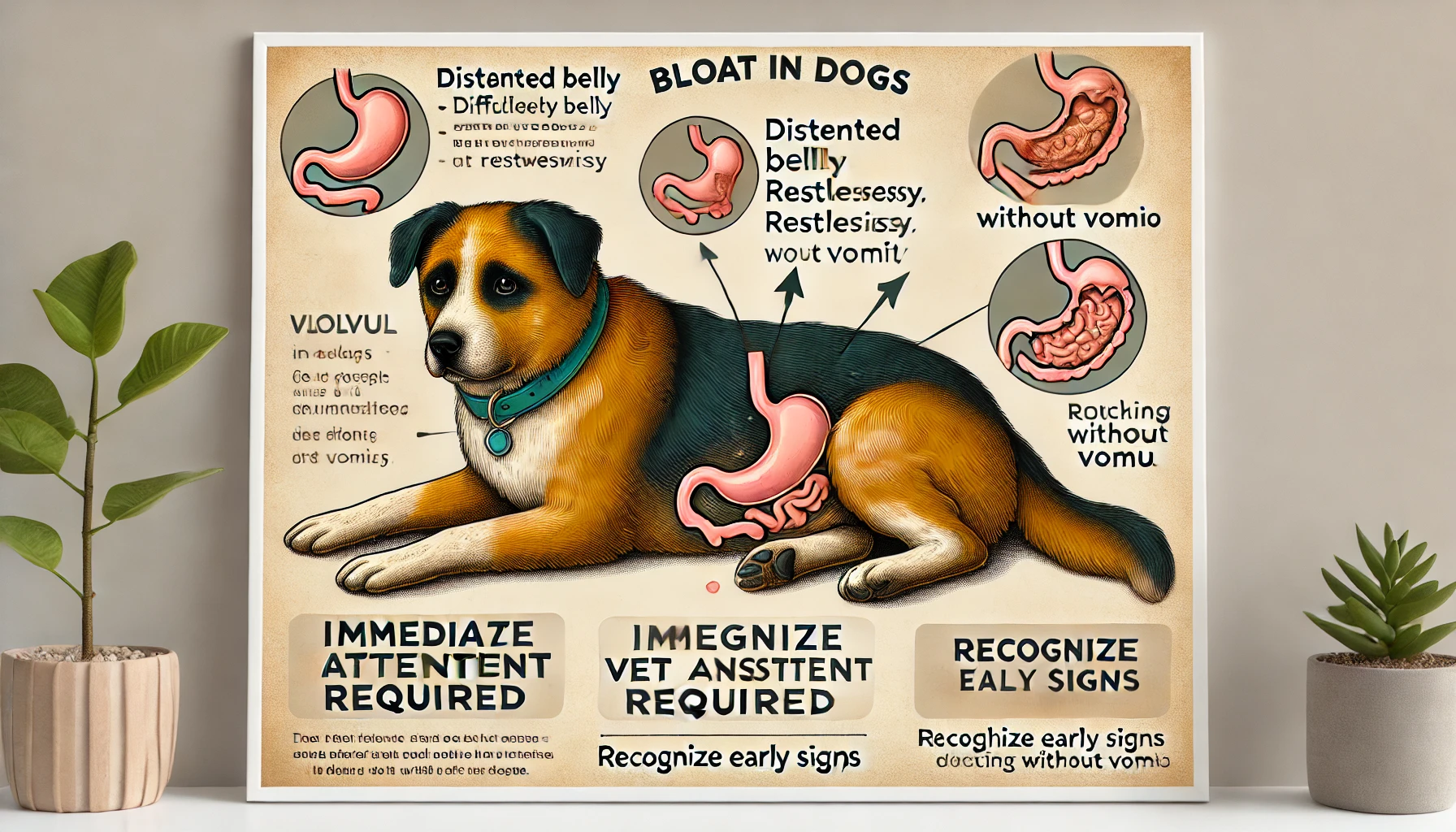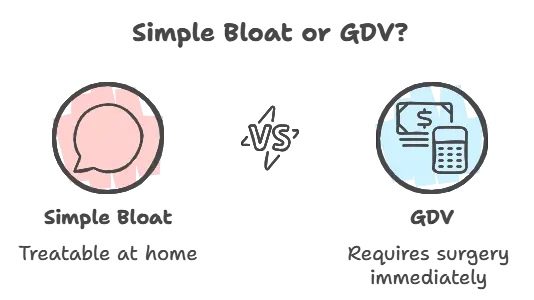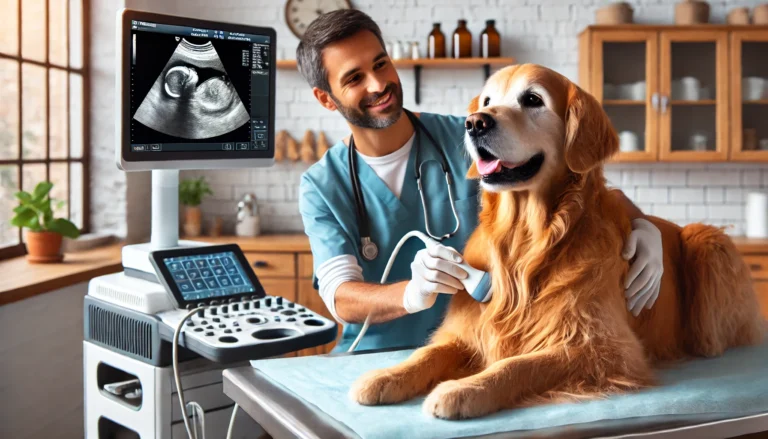7 Critical Signs of Bloat in Dogs You Can’t Ignore

Bloat in dogs is a life-threatening condition that requires immediate medical attention. Also known as Gastric Dilatation-Volvulus (GDV), this condition occurs when the dog’s stomach fills with gas, fluid, or food, causing it to twist. The twist blocks blood flow, leading to a critical situation that can result in death within hours if not treated.
Dog owners must be aware of the symptoms of bloat in dogs, such as a dog bloated stomach, drooling, and restlessness, to act fast in emergencies. Certain factors, such as dog food ingredients with high fat content or gulping food too quickly, increase the risk of bloat, especially in larger breeds. Early detection and timely treatment are essential for saving your pet’s life.
What is Bloat in Dogs?
Bloat in dogs, also known as Gastric Dilatation-Volvulus (GDV), is a severe medical emergency. This condition occurs when the dog’s stomach becomes overly filled with gas, liquid, or food and then twists. The twist cuts off blood flow to the stomach and other vital organs, leading to tissue death and shock. If not treated immediately, it can cause death in a matter of hours.
Difference Between Simple Bloat and GDV
- Simple Bloat: The stomach expands but does not twist. This type can be treated with at-home remedies if detected early.
- GDV: The stomach twists along its axis, leading to a blockage of blood and gases. This condition requires immediate surgical intervention.

Key Terms Related to Bloat
- Dog bloated stomach: A visibly swollen or distended abdomen dog.
- Dog abdomen bloated: A hardened or swollen belly that may feel tight to the touch.
- Distended belly dog: Dogs with bloat often appear restless and may refuse to lie down due to discomfort.
Knowing what bloat looks like can help owners act quickly. Watch for behavioral changes, including anxious pacing and difficulty breathing.
Symptoms of Bloat in Dogs
Recognizing the early signs of bloat in dogs is crucial for saving your pet’s life. The symptoms can escalate quickly, so owners must act immediately when they notice any of these signs.
Common Symptoms of Bloat in Dogs
| Symptom | Description |
|---|---|
| Restlessness | Dog seems anxious, unable to sit or lie down comfortably |
| Distended abdomen | Swollen or dog bloated stomach that feels hard |
| Drooling excessively | Continuous drooling with or without nausea |
| Unproductive vomiting | Attempting to vomit but producing little or no output |
| Heavy panting or rapid breathing | Dog breathes heavily, even while resting |
| Weakness or collapse | If untreated, bloat can cause shock and fainting |
| Refusal to eat | Loss of appetite even though the dog bloated tummy feels full |
Puppy Bloat Signs
Young dogs are also at risk. Symptoms of puppy bloat include whining, swollen belly, and lethargy. These signs can progress to severe pain if untreated.
For Your Information
Can dogs eat oranges? Yes, but only in moderation. Oranges can provide your dog with vitamin C, fiber, and hydration, but the high sugar content makes it important to limit portions.
What Are the First Signs of Bloat in a Dog?
One of the first signs of bloat in a dog is restlessness. The dog will pace, drool excessively, and may attempt to vomit without success. A bloated abdomen in dogs and whining from discomfort are red flags that must not be ignored.
Bloat can worsen in a short time. If your dog’s condition progresses to panting, collapse, or a distended stomach, it may be a sign of GDV, requiring urgent veterinary intervention.
What Causes Bloat in Dogs?
Understanding what causes bloat in dogs is key to preventing it. While the exact cause isn’t always known, several factors increase the risk of both simple bloat and GDV.
Top Causes of Bloat in Dogs
| Cause | Explanation |
|---|---|
| Dog food ingredients with high fat | Diets rich in fat slow digestion and increase the chance of bloating. |
| Eating too quickly | Dogs that gulp food swallow excessive air, causing the stomach to expand. |
| Large meals | Feeding large portions at once can overwhelm the stomach. |
| Physical activity after eating | Exercise after meals interferes with digestion, leading to dog bloated stomach. |
| Genetic predisposition | Some breeds, like Great Danes and German Shepherds, are prone to canine bloat causes. |
| Stress or anxiety | Stressful events may trigger dog bloating in sensitive pets. |
What Causes Canine Bloat in Puppies?
Even young dogs can experience bloat. Canine bloat in puppies can result from overfeeding, gulping milk or water too fast, or being overly active after meals. Monitoring their feeding habits can prevent this.
Why Dog Breeds Matter
Large and deep-chested breeds, such as Great Danes, Boxers, and Weimaraners, are particularly vulnerable to bloat in dogs. Breeds like these should be monitored closely after meals, as they have a higher chance of developing twisted stomach dogs symptoms.
How to Help a Bloated Dog: Immediate Actions
If you suspect bloat in dogs, act quickly. GDV is a medical emergency that can worsen rapidly. Here are the steps you should take to stabilize your pet before reaching a veterinarian.
Steps to Help a Dog with Bloat
- Don’t Delay – Call Your Veterinarian Immediately
- If you notice bloat symptoms in dogs, contact your vet or the nearest animal emergency clinic. Time is critical.
- Avoid Feeding or Giving Water
- Do not feed your dog or allow it to drink, as food or water can worsen the condition.
- Minimize Movement
- Keep your pet calm and avoid excessive movement to prevent further stomach twisting.
- Assess for Signs of GDV
- Check for signs like a distended stomach dog or attempts to vomit with no success. These symptoms indicate the need for immediate surgery.
Dog Bloated Stomach Home Remedy – When It’s Not GDV
In cases of simple bloating caused by gas or overeating, mild remedies may help:
- Walk the Dog Gently: A light walk can encourage digestion and release trapped gas.
- Gas Relief for Dogs: Over-the-counter medications like simethicone may provide relief.
- Massage the Stomach: Gently rubbing the dog’s belly can help alleviate discomfort in cases of food bloat.
However, if the dog bloated stomach persists or the symptoms worsen, head to the vet immediately.
What Not to Do
- Don’t Wait to See if It Passes: Time is crucial with bloating in dogs. Delaying treatment could cost your dog its life.
- Don’t Try to Induce Vomiting: Vomiting can worsen the twisting of the stomach if GDV is present.
Canine Bloat Treatment and Surgery
When a dog is diagnosed with Gastric Dilatation-Volvulus (GDV), emergency medical intervention is essential. Simple bloat may be treated at home if the condition is mild, but severe dog bloat requires professional care.
Veterinary Treatment for Dog Bloat
| Treatment Option | Description |
|---|---|
| Decompression of the Stomach | A tube is inserted through the dog’s mouth to release gas and relieve pressure. |
| Needle Aspiration | In critical cases, a needle may be used to release gas directly through the abdomen. |
| Stabilization with IV Fluids | IV fluids help prevent shock while preparing the dog for surgery. |
| Surgery (Gastropexy) | The twisted stomach is untwisted and stitched to the abdominal wall to prevent future bloating episodes. |
Dog Bloat Treatment at Home – When Possible
- If your dog experiences mild bloating from overeating or gas, try gas relief for dogs like simethicone.
- Home remedies for dog bloat (like gentle walks) can help if the bloating is not due to GDV.
- However, if dog bloated stomach symptoms persist or worsen, emergency care is required.
How Long Does Bloat Take to Kill a Dog?
In cases of GDV, death can occur within 2-6 hours without treatment. The speed at which the condition progresses makes quick intervention vital. Delaying surgery can reduce survival chances drastically.
Canine Bloat Surgery – Recovery and Prognosis
After surgery, dogs typically need 24-48 hours of observation. Recovery involves monitoring for complications like infections or irregular heart rhythms. A successful gastropexy can prevent future bloat, though careful feeding practices remain essential.
How to Prevent Bloat in Dogs
Preventing bloat in dogs involves adjusting feeding practices, managing physical activity, and monitoring high-risk breeds. While you can’t eliminate the risk entirely, these steps can significantly reduce the chances of bloat or GDV.
Tips on How to Prevent Bloat in Dogs
| Prevention Tip | Details |
|---|---|
| Feed Smaller, Frequent Meals | Avoid giving one large meal. Divide portions to ease digestion. |
| Use a Slow Feeder Bowl | Helps prevent dogs from gulping food and swallowing air. |
| Monitor Water Intake | Ensure your dog doesn’t drink large amounts of water at once, especially before or after meals. |
| Avoid Exercise After Meals | Wait at least 1 hour after meals before allowing your dog to run or play. |
| Choose the Right Food | Avoid dog food ingredients with high fat, which slow digestion. Look for balanced formulas. |
| Consider Gastropexy Surgery | For breeds prone to bloat in dogs (like Great Danes), preventive surgery can reduce the risk of GDV. |
What Causes Bloating in Dogs After Eating?
Dogs that eat too quickly or consume fatty foods are more prone to food bloat in dogs. Using a slow-feeder bowl and avoiding table scraps can reduce this risk.
Can Small Breed Dogs Get Bloat?
While bloat in dogs primarily affects large, deep-chested breeds, small breed dogs are not immune. Overeating or gulping water too fast can still cause a dog’s belly to become bloated.
With these preventive measures, you can reduce the risk of your dog developing life-threatening bloat. However, always monitor your pet for any bloat symptoms dog owners need to act on immediately.
Frequently Asked Questions (FAQs)
1. What are the first signs of bloat in a dog?
The earliest signs include restlessness, drooling, and unsuccessful attempts to vomit.
2. How long does bloat take to kill a dog?
Without treatment, GDV can cause death within 2-6 hours.
3. What can you give a dog for gas?
Simethicone or other over-the-counter gas relief for dogs can help with simple bloating, but GDV requires immediate veterinary care.
4. Can small breed dogs get bloat?
Yes, though it is more common in large breeds, small dogs can develop food bloat from overeating or drinking water too fast.
5. How to get rid of bloat in dogs?
Mild cases may be relieved with gentle walking or gas medication, but GDV needs emergency surgery.






